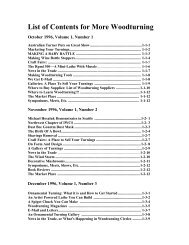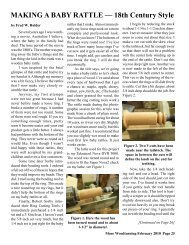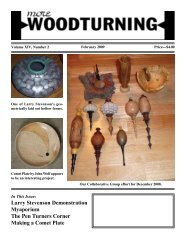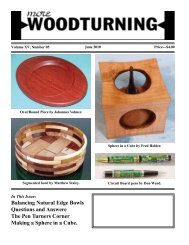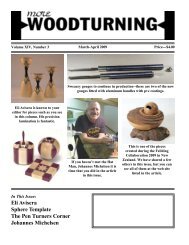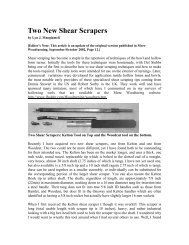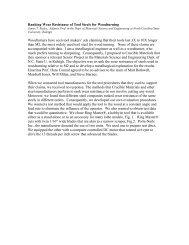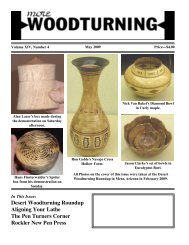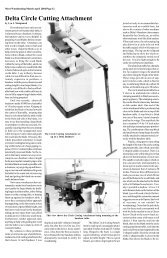Michael Mocho Demonstration 2009 Symposium of the AAW The ...
Michael Mocho Demonstration 2009 Symposium of the AAW The ...
Michael Mocho Demonstration 2009 Symposium of the AAW The ...
You also want an ePaper? Increase the reach of your titles
YUMPU automatically turns print PDFs into web optimized ePapers that Google loves.
Using two OpposedBowl Steadies as aCenter Steadyby Joel Rakower and Don LindsleyWhen doing deep hollowing itis <strong>of</strong>ten helpful to use a center steadyto keep <strong>the</strong> workpiece centered andto minimize vibration. But centersteadies tend to be expensive, andmany have an arm at “12 o’clock”that prevents using a laser guideduring <strong>the</strong> hollowing process.We suggest using two Onewaybowl steadies to proxy for a centersteady. As <strong>the</strong> name suggests, <strong>the</strong>bowl steady is designed to support<strong>the</strong> walls <strong>of</strong> a bowl as it is shapedand brought to final wall thickness.Typically it is mounted to <strong>the</strong> left<strong>of</strong> <strong>the</strong> bowl (as you face <strong>the</strong> headstock).Figure 1. Two Oneway bowlsteadies stacked so as to serveas a center steady for a hollowform.When hollowing, we simplyadd a second steady on <strong>the</strong> righthandside. Depending on <strong>the</strong> shape<strong>of</strong> <strong>the</strong> piece being hollowed, it maywork to mount <strong>the</strong> steadies side byside. You can also stack <strong>the</strong> steadiesas shown in Figure 1. To stack <strong>the</strong>m,you may have to use a bolt about ½”longer than <strong>the</strong> ones provided byOneway. <strong>The</strong> bolt is a U.S. standard½” x 13.An advantage <strong>of</strong> stacking isthat it is easier to align <strong>the</strong> steadieson ei<strong>the</strong>r side <strong>of</strong> <strong>the</strong> workpiece.Note that in Photo 1, <strong>the</strong>steadies are about as close toge<strong>the</strong>ras <strong>the</strong>y can get: <strong>the</strong> end <strong>of</strong> <strong>the</strong> upperbase butts up against <strong>the</strong> base for<strong>the</strong> post <strong>of</strong> <strong>the</strong> lower one. You canovercome this limitation by “scissoring”<strong>the</strong> two bases, such that <strong>the</strong>upper base can extend past <strong>the</strong> post<strong>of</strong> <strong>the</strong> lower one (Figure 2).Figure 2. <strong>The</strong> bowl steadieswith <strong>the</strong> bases “scissored” topermit moving <strong>the</strong> wheels closertoge<strong>the</strong>r. <strong>The</strong> laser spot from <strong>the</strong>hollowing system is visible on<strong>the</strong> left side <strong>of</strong> <strong>the</strong> photo.If you do this, you’ll also haveto pivot <strong>the</strong> arms on each post sothat wheels contact <strong>the</strong> workpiece atapproximately right angles. Figure2 shows <strong>the</strong> laser spot (but not <strong>the</strong>laser arm itself) <strong>of</strong> <strong>the</strong> hollowingsystem, illustrating how <strong>the</strong> pairedsteadies are compatible with thatsystem.<strong>The</strong> authors are members <strong>of</strong><strong>the</strong> Long Island Woodturners’ Association.Tip for using aSpindle Tapby Don LindsleyA spindle tap, such as <strong>the</strong> onemade by Beale, is used to cut threadsinto blocks <strong>of</strong> wood so that <strong>the</strong>ymay be mounted directly on <strong>the</strong>headstock <strong>of</strong> a la<strong>the</strong> without use <strong>of</strong>a faceplate. I have found it useful formaking jam chucks and home-madescrew chucks, among o<strong>the</strong>r items.To use <strong>the</strong> tap, you pre-bore ahole that is just larger than <strong>the</strong> rootdiameter <strong>of</strong> <strong>the</strong> tap, <strong>the</strong>n use <strong>the</strong> tapto thread <strong>the</strong> wood. As with any tap,you need to keep it coaxial with <strong>the</strong>hole in order to make clean, properlyaligned threads. Instructions suppliedwith <strong>the</strong> tap suggest mounting<strong>the</strong> wood block to <strong>the</strong> headstock <strong>of</strong>your la<strong>the</strong> using a 4-jawed chuck,and using a point center in <strong>the</strong>tailstock to keep <strong>the</strong> tap properlyaligned. Lock <strong>the</strong> headstock anduse a wrench to advance <strong>the</strong> tap into<strong>the</strong> pre-bored hole. To keep <strong>the</strong> tapaligned, you must simultaneouslyadvance <strong>the</strong> tailstock to keep <strong>the</strong>[Continued on Page 38]Q&A Continued from Page34first, apply <strong>the</strong> thin CA and take onefinal light sheer scrape again, andput more glue on <strong>the</strong> outside edge <strong>of</strong><strong>the</strong> bark again. Now on <strong>the</strong> insideas I sneak up on <strong>the</strong> wall thickness,repeat <strong>the</strong> process <strong>of</strong> double glue.This seems to stabilize <strong>the</strong> bark andhold it on. Finish sanding as youwould any o<strong>the</strong>r natural edge. Youcan put <strong>the</strong> same finish on <strong>the</strong> barkas you do for <strong>the</strong> rest <strong>of</strong> <strong>the</strong> bowl.Lyle JamiesonMore Woodturning August <strong>2009</strong> Page 35



